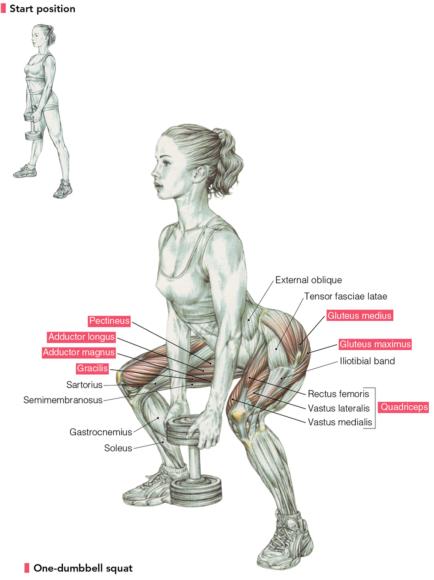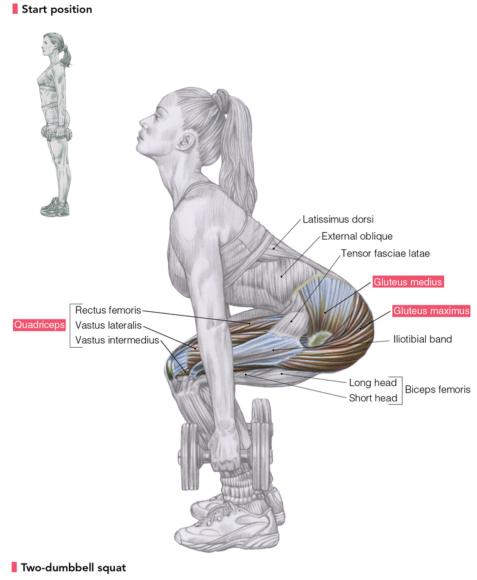The Squat, Including Dumbbell Variations
This is an excerpt from Delavier's Women's Strength Training Anatomy Workouts by Frederic Delavier,Michael Gundill.
Squat
The squat belongs in the basic, multiple-joint exercise category because the hip, knee, and ankle joints are mobilized. As a result, the squat recruits many muscles in addition to the quadriceps: the glutes, hamstrings, lumbar muscles, and calves.
The squat is considered a good starting exercise because it stimulates many muscle groups of the lower body.
How to Do It
Stand with your feet about shoulder-width apart, and place a barbell on your upper back. Keeping your back arched very slightly backward, bend your legs just until your torso starts to really bend forward. When this happens, thigh involvement lessens and the lumbar muscles begin to do the majority of the work.
When you have reached your low position, push down through your heels to straighten your legs. Once you are upright, perform another repetition.
Pro
- The whole lower-body and part of the upper-body muscles are recruited, which makes the squat one of the most complete exercises.
Con
- The squat is a very difficult exercise to perform and requires athletic skills a beginner may not have.
 |
Because this exercise is exhausting, it carries some risk for the knees and back. Hanging at a pull-up bar to stretch your spine after your workout is advised, as it is with every workout. |

Squat Depth
The deeper you lower the weight, the more intense the squat becomes, because as you increase your range of motion, you are not recruiting only your quadriceps. Your hamstrings and especially your buttocks are going to be heavily recruited, as well. So, it seems to be a good idea to squat deep. From a muscular stand point, this is correct. But this is also where your morphology will come into play. The taller you are, the more you will have to bend your torso forward in order to keep your equilibrium as you squat down. In this position, the risk of spinal injury increases dramatically.
Many people claim that bending the torso forward during a squat is bad technique. But morphologically, if you have long quadriceps and a shorter torso, it is mechanically impossible to keep your back straight as you go down in squats. You must bend forward to keep your balance. This is why it is easier to keep your back straight using a Smith machine because there is no balance issue!
If you find that you have to bend forward to a dangerous level in free squats, you would be wise to find an alternative to this exercise rather than waste hours trying to master a technique that you cannot perform morphologically.

Short femurs mean less forward lean; long femurs mean more forward lean. The longer your femur is, the more you will have to bend over to keep your equilibrium. Therefore, as a general rule, the taller you are, the more dangerous it is for your spine to squat deep.
Dumbbell Variations
- When you grab one dumbbell between your legs, your thighs have to work harder, rendering the squat more effective. As an alternative, you can use a strong elastic band or squat on one leg only.

Dumbbell Variations
- Grabbing two dumbbells adds even more resistance. The main advantage of dumbbells over a barbell is that they make it easier to keep your back straight and to keep your balance. However, as you grow stronger, dumbbells will not offer the resistance required to progress even more. This is when graduating to a long bar is required. By then, you should be able to keep your balance despite the overload placed on your legs.

Learn more about Delavier's Women's Strength Training Anatomy Workouts.
More Excerpts From Delavier's Women's Strength Training Anatomy WorkoutsSHOP

Get the latest insights with regular newsletters, plus periodic product information and special insider offers.
JOIN NOW


